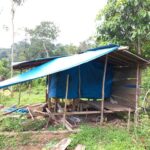Two German geologists, Dr. Henno Martin and Dr. Herman Korn, went into hiding around the Kuiseb Canyon area, Namibia, for 2.5 years at the beginning of WW2 in 1940 to avoid internment by the South African Union government. During that time, they lived mainly off the land. Herman Korn died in 1946 in a traffic accident. Henno Martin was a professor of geology at the University of Cape Town after the war and later at Göttingen, Germany, where he died in 1998. Henno Martin published the book The Sheltering Desert in 1957. Based on their experiences of this ordeal, it was also the basis for the same-named movie in 1991.

Shelters of Henno Martin and Herman Korn
During these 2.5 years, both Martin and Korn lived at three different shelters. The first one was an overhanging rock, which they called ‘Karpfenkliff’ (‘Carp’s cliff’), due to a pool in the Kuiseb river below them, which was full of fish. The second and third shelters were stone and wood shacks. The function of all three shelters was never to keep out rain or cold temperatures but to provide shade, protect against strong winds, and act as a first line of protection against hyenas. The Namibian government now protects the first shelter, part of the Namib-Naukluft National Park.
Location, advantages, and disadvantages of the first shelter

This first shelter is a typical place somebody would initially choose when under pressure. It is a natural given. The overhanging and south-facing rocks provide day-long protection against the sun; in front, there is a good overview of parts of the canyon below, and stone walls can quickly close both sides.
Behind and above them is a large flat plateau with plants and grasses, which will attract mountain zebras, oryxes, ostriches, and springbuck for grazing. Mountain zebras move daily from the canyon to the plateau and back again. Klipspringer and Steenbuck will use granadillas (a local expression for the wild, void, carved-out mountainous landscapes) and canyon side walls. It is a good place for hunting.

Water is available in the canyon at pools or holes dug into the sand. The disadvantage of the first shelter location was that the distance to this water was too long, and long hikes were necessary to get back and forth.
Hyenas were never a problem, as the men also had a dog with them, who alerted them in case of danger. Most disturbing for Martin and Korn was the nearly constant clapping of mountain zebra hooves on the rocks at night.
Lessons learned from the first Henno Martin shelter:
- Finding initially a location with an overhanging rock, which provides shade the whole day long, is most important
- The second priority is the availability of a nearby water source, which was not the case at this shelter
- However, the location was good for hunting. The biggest game they shot was not an animal at the plateau but a feral cattle bull, and they had to carry the whole weight of meat from the canyon bottom up to their shelter on the plateau rim.
.





